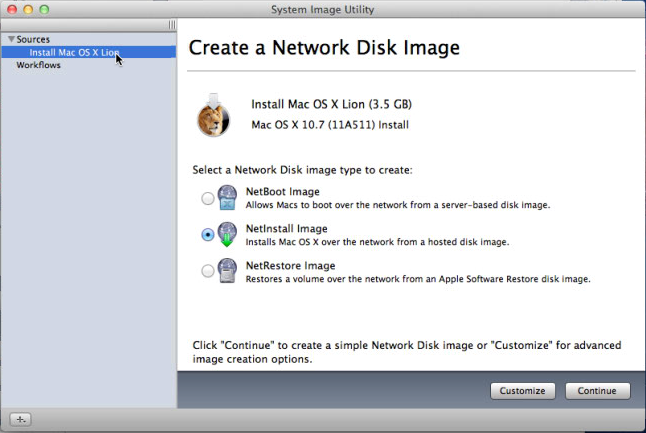
- #APPLE NETBOOT SERVER FOR MAC HOW TO#
- #APPLE NETBOOT SERVER FOR MAC INSTALL#
- #APPLE NETBOOT SERVER FOR MAC UPGRADE#
- #APPLE NETBOOT SERVER FOR MAC SOFTWARE#
- #APPLE NETBOOT SERVER FOR MAC DOWNLOAD#
#APPLE NETBOOT SERVER FOR MAC HOW TO#
Why would I rename the hard drive to something like "NetBoot image"? Could I not just leave the name as Macintosh HD? Also, can you explain how to update the NetBoot image, if it's quite simple? Thank you for the explanation and links! Just a couple of questions. Would I then be able to deploy the OS X 10.9.5 image to the new mac? Is there any way around this? I really don't have the resources to create a new 10.11.1 image.
#APPLE NETBOOT SERVER FOR MAC UPGRADE#
So if I upgrade the DeployStudio server to 10.11.1, and create a new NBI. I want to deploy one of our existing images which is OS X 10.9.5.

Here's my setup DeployStudio server is running OS X 10.10.3, New Mac is running OS X 10.11.1. Then you can NetBoot the other iMacs and deploy the updated image Copy this to the server and make it the default
#APPLE NETBOOT SERVER FOR MAC INSTALL#
Get a new iMac, power on and install Deploy Studio, create a new NBI Your server side NBI image needs to be new enough to boot the new hardwareĪnd then obviously the Image you deploy needs to be new enough to run on the new hardware, The OS the Mac ships with is the lowest version that will run it.there are some exceptions to this rule just to confuse things In the long run you'll get more flexibility and easier/faster updating if you use the best practice workflow and convert everything over to packages.
#APPLE NETBOOT SERVER FOR MAC SOFTWARE#
You can create a static image with all your software and configuration complete, but again that isn't the recommended method. Thankfully, there is CreateUserPkg for doing just that. For example, you'll have to have a package or some other method that creates a local user account on the AutoDMG image. You can then easily change the OS version and have the same list of packages deployed. This assumes that you are using the recommended DeployStudio method of using packages for everything, even the OS.
#APPLE NETBOOT SERVER FOR MAC DOWNLOAD#
And it's easy: Download the OS from the Mac App Store, drag it into AutoDMG. Once your NetBoot image is up and running, you can create a new OS image. The NetBoot OS volume must have a different name from any other volume that might be mounted on the Mac. If you leave the NetBoot image at the default name of "Macintosh HD" the NetBoot image will not work. If it all works, rename the volume on the Mac you used to create the image back to "Macintosh HD." It is critical that you rename the hard drive on the Mac when capturing the image and rename it back. Test it on another iMac (as well as other hardware.) Capture the Image with the image capture tool, and upload to the server. Take one of your iMacs, rename the hard drive to something like "NetBoot Image" and customize it with the software, tools, and settings you want when NetBooting. So you absolutely have to update your NetBoot image to the OS that shipped with your new iMacs and update your OS image accordingly. The OS bootstrapper/installer will see the Mac hardware version, check to see if it is supported hardware, and go " NOPE!" Apple does not back port hardware support to old OS versions.

But that's not an ideal solution, i'd rather run a direct, native server.īSDPy does not support diskless netbooting, so that option won't work.But whatever way you cut it you can't deploy/run 10.9.5 on the new iMacsTo reiterate, there is no possibly you can downgrade the OS on a brand new iMac to 10.9.5. I am currently playing around with running 10.11 in a virtual machine on my laptop. And I tend to work on older computers more than new, so I still need NetBoot for years to come. I know Apple may be working towards killing NetBooting entirely, but it's not dead yet. I did some googling but only found solutions that support NetInstall, and not diskless-NetBoot images. DHCP is easy enough to replace I'm sure, but NetBoot serving doesn't seem as straight forward. Or what is more often the case, on wifi-only networks, I just plug in directly mac to mac and use DHCP service also running on my laptop. I run this on my laptop, plug into someone's network, and BAM. I use NetInstall images too for installing the OS but I primarily use Diskless NetBoot images to diagnose and repair disk problems. I fix Macs for a living and have been using Netbooting for 10 years as my faster, better version of booting a customers Mac off a USB utility disk. This won't affect 99.5% of people but I'm in the minority.

Apple has removed, among many other things, DHCP serving and NetBoot Serving from their 'server' app in conjunction with the new OS.


 0 kommentar(er)
0 kommentar(er)
